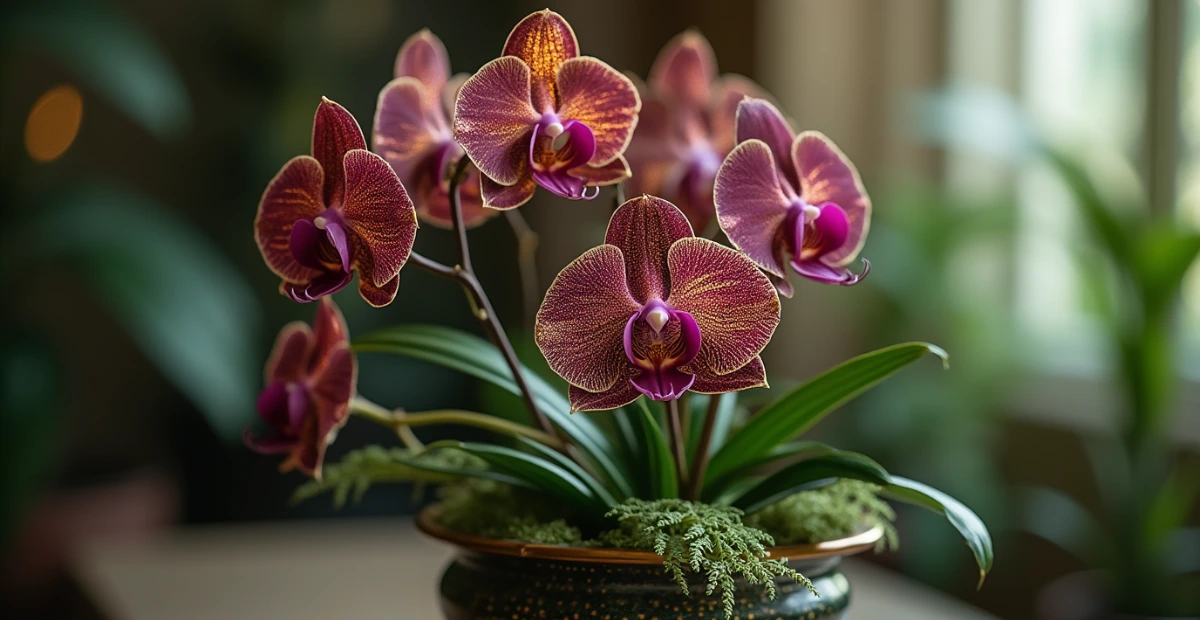Table of Contents
advertisement
Opening: A Stunning Touch to Your Home
Imagine walking into a room and immediately being drawn to a plant so striking, it’s as if it has a jewel-like glow. That’s what a Jewel Orchid can bring to your home. With its glossy, dark green leaves and unique veined patterns, this plant stands out in the best way possible. It’s no wonder that so many plant lovers are eager to add this rare beauty to their collection.
However, caring for your Jewel Orchid requires more than simply admiring its beauty. As an indoor plant, it has specific needs in terms of light, temperature, humidity, watering, and fertilization. The good news is that with the right care, your Jewel Orchid can thrive and add an elegant touch to your space for years to come.
In this guide, you’ll discover everything you need to know to ensure your Jewel Orchid stays healthy, vibrant, and truly a masterpiece of your indoor garden. From optimal growing conditions to troubleshooting common problems, we’ll walk you through each step of caring for this beautiful plant.
Understanding the Jewel Orchid Plant
Before we dive into care tips, let’s first take a moment to get familiar with your Jewel Orchid. This plant, known scientifically as Ludisia discolor, is native to Southeast Asia and parts of China. It’s called the Jewel Orchid because of its stunning foliage that resembles precious gems, often with deep green leaves and silver or red veins running through them. In fact, its beauty is its main attraction, and it’s prized for its striking appearance and relatively low-maintenance care.
Characteristics of Jewel Orchid
- Leaves: The leaves of the Jewel Orchid are its standout feature. They are dark green, with contrasting veins that appear almost metallic, giving them a jewel-like shine under the right light.
- Flowers: Though often grown for its leaves, the Jewel Orchid also produces delicate white or pinkish flowers. These blooms are less frequently seen than the foliage, as the plant is more commonly grown for its stunning leaves.
- Growth Habit: Jewel Orchids grow slowly and stay relatively small, making them ideal for smaller spaces or as part of a larger indoor plant collection.
If you’re ready to take on the responsibility of caring for such a remarkable plant, let’s talk about the growing conditions it thrives in.
advertisement
Optimal Growing Conditions for Jewel Orchid
To ensure your Jewel Orchid thrives, it’s important to replicate the conditions it would experience in its native habitat. While they are quite adaptable, there are a few key factors to keep in mind regarding light, temperature, and humidity.
Light Requirements
One of the most important factors in Jewel Orchid care is its light requirements. Jewel Orchids thrive in low to moderate light. Direct sunlight can scorch their delicate leaves, so it’s best to place them in a location where they receive indirect light.
- Best spots: Near an east-facing window or in a well-lit corner of a room works well.
- Avoid direct sunlight: Direct exposure to bright sun will cause the leaves to burn and lose their color.
- Low light tolerance: While Jewel Orchids can survive in lower light, they grow best when provided with moderate, filtered light.
Temperature and Humidity
Jewel Orchids are native to warm, humid environments, so it’s essential to replicate these conditions as much as possible in your home.
- Temperature: Jewel Orchids prefer warm temperatures, ideally between 65°F to 75°F (18°C to 24°C). They can tolerate temperatures slightly above or below this range, but drastic temperature changes should be avoided.
- Humidity: These plants thrive in high humidity, around 60% or higher. If your home is dry, you may need to take extra steps to increase humidity.
- Tip: Use a humidifier or place the plant on a humidity tray (a shallow tray filled with pebbles and water). Misting the leaves lightly can also help maintain humidity.
- Indoor Environment: Bathrooms or kitchens, where humidity levels tend to be naturally higher, are often good spots for Jewel Orchids.
advertisement
How to Water and Fertilize Your Jewel Orchid
Watering and fertilizing are two areas where many plant owners make mistakes, especially with more delicate plants like the Jewel Orchid. Let’s break down exactly how to do it right.
Watering Tips for Jewel Orchid
Jewel Orchids require moderate watering, but they are sensitive to overwatering. The key is to keep the soil consistently moist but not soggy. Here’s how to water your plant correctly:
- Check soil moisture: Stick your finger about an inch into the soil. If it feels dry, it’s time to water. If it still feels damp, wait a day or two before watering again.
- Avoid waterlogging: To prevent root rot, make sure your pot has good drainage. Never let your plant sit in water for extended periods.
- Watering method: Bottom watering can be an effective way to ensure even moisture without over-wetting the leaves.
Fertilizing Your Jewel Orchid
Jewel Orchids don’t need a lot of fertilizer, but a regular feeding schedule will help them grow healthier and stronger.
- Fertilizing frequency: During the growing season (spring and summer), fertilize once a month using a balanced liquid fertilizer. Reduce the frequency to every 6-8 weeks in the fall and winter when the plant’s growth slows.
- Fertilizer type: Use a balanced, water-soluble fertilizer (such as 20-20-20) or an organic option. This will provide the necessary nutrients for the plant’s growth without overwhelming it with excess nutrients.
Repotting Your Jewel Orchid: When and How to Do It
As your Jewel Orchid grows, it may outgrow its pot or the soil may become compacted, hindering proper root growth. Repotting is a necessary step to ensure your plant continues to thrive.
Signs It’s Time to Repot
advertisement
- Root-bound: If the roots are growing out of the drainage holes or tightly packed in the pot, it’s time to repot.
- Slow growth: If your plant is growing slowly or appears to have stopped growing, it may be because the roots have no room to spread.
- Soil deterioration: Over time, the potting mix breaks down, and it’s important to refresh the soil.
How to Repot Jewel Orchids
- Step 1: Choose a new pot that is 1-2 inches larger in diameter than the current pot.
- Step 2: Gently remove the plant from its pot. Take care not to damage the roots.
- Step 3: Trim any dead or damaged roots.
- Step 4: Fill the new pot with fresh, well-draining potting mix.
- Step 5: Place the plant in the new pot and cover the roots with soil. Water lightly after repotting.
Common Problems with Jewel Orchids and How to Fix Them
Despite their beauty, Jewel Orchids can experience a few common issues that every plant parent should be prepared to address. Let’s look at some of these problems and how to fix them.
Pests and Diseases
Jewel Orchids are relatively pest-resistant, but they can sometimes fall victim to the following:
- Mealybugs and aphids: These pests can be found on the underside of leaves or near the stems. Use a cotton swab dipped in rubbing alcohol to wipe them off.
- Spider mites: These tiny pests can cause leaf discoloration and webbing. Increase humidity and treat the plant with insecticidal soap.
- Fungal infections: If you notice dark spots or a powdery film on the leaves, it could be a sign of fungal issues. Use a fungicide and remove affected leaves.
Leaf Yellowing or Browning
If you notice your Jewel Orchid’s leaves turning yellow or brown, it’s often due to one of the following reasons:
- Overwatering: Root rot caused by overwatering can lead to yellowing leaves. Let the soil dry out before watering again, and ensure good drainage.
- Low humidity: Jewel Orchids love moisture. If the humidity is too low, you may see crispy, brown edges on the leaves. Increase humidity levels to help the plant bounce back.
- Nutrient deficiency: If the plant’s leaves are pale or yellowing, it could be lacking essential nutrients. Try feeding the plant with a balanced fertilizer.
advertisement
Pruning and Maintenance for a Healthy Jewel Orchid
Regular maintenance, including pruning, will help your Jewel Orchid stay in top shape. Here’s how to keep your plant healthy:
Pruning Techniques
- Remove dead leaves: Prune any leaves that are damaged, yellowing, or diseased to encourage new growth.
- Trim back leggy growth: If the plant becomes too stretched out, trimming back the longer stems can help it grow fuller.
General Maintenance Tips
- Leaf care: Occasionally wipe the leaves with a damp cloth to remove dust. This not only keeps the plant looking shiny but also helps it absorb light more efficiently.
- Check for pests regularly: Inspect your plant every couple of weeks for any signs of pests.
Conclusion: Master the Art of Jewel Orchid Care
Caring for a Jewel Orchid is a rewarding experience that will bring beauty and tranquility to your home. By providing the right light, humidity, watering, and fertilizing, you can enjoy the stunning foliage of this plant for years to come.
Remember, consistency is key. Pay attention to your plant’s needs, monitor its growth, and address any problems as soon as they arise. With these tips in hand, you’re ready to become a Jewel Orchid expert.
Try Your Hand at Growing a Jewel Orchid
Don’t wait—add a Jewel Orchid to your home today and enjoy the elegance it brings. By following these care tips, you’ll be well on your way to maintaining a vibrant and healthy plant. Let your Jewel Orchid shine in your space!
FAQ About Jewel Orchid Care
1. How often should I water my Jewel Orchid?
Water your Jewel Orchid when the top inch of the soil feels dry. Be sure not to overwater, as this can lead to root rot. Always ensure the plant’s pot has good drainage.
2. Can Jewel Orchids survive in low light?
advertisement
Yes, Jewel Orchids can thrive in low to moderate light. However, they grow best in indirect light, so avoid placing them in direct sunlight.
3. What type of fertilizer is best for Jewel Orchids?
A balanced, water-soluble fertilizer like 20-20-20 works well for Jewel Orchids. Fertilize once a month during the growing season to keep your plant healthy.
4. Why are my Jewel Orchid’s leaves turning yellow?
Yellow leaves can be a sign of overwatering, low humidity, or nutrient deficiencies. Adjust your watering schedule and increase humidity to fix the issue.
5. When is the best time to repot a Jewel Orchid?
Repot your Jewel Orchid every 1-2 years or when it becomes root-bound. Early spring, just before the growing season begins, is the best time to repot.
Table: Recommended Fertilizer for Jewel Orchids
| Type of Fertilizer | Recommended Brand | Frequency | Ideal for Plant Growth |
|---|---|---|---|
| Organic, Water-soluble | Neptune’s Harvest | Monthly during the growing season | Boosts root development and overall health |
| Synthetic, Balanced 20-20-20 | Miracle-Gro | Monthly during the growing season | Provides essential nutrients for growth |
Now that you know how to properly care for your Jewel Orchid, it’s time to give it the attention it deserves. Follow these simple steps, and you’ll be rewarded with a stunning indoor plant that brings beauty to your home. Happy gardening!


